Collaboration with Environmental Protection Administration Taiwan (EPAT)
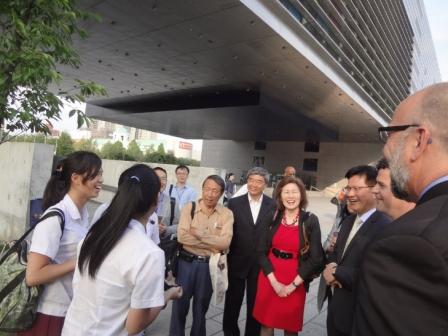 Jane Nishida, EPA Principal Deputy Assistant Administrator for International and Tribal Affairs, interacting with students from the Kids Making Sense program in Taiwan.
Jane Nishida, EPA Principal Deputy Assistant Administrator for International and Tribal Affairs, interacting with students from the Kids Making Sense program in Taiwan. Taiwan is one of the environmental leaders in the Asia Pacific region. EPA established an agreement with the American Institute in Taiwan (AIT) in 1993. EPA works with the Environmental Protection Administration Taiwan (EPAT) to implement the agreement.
The close partnership has now evolved into a robust platform for sharing experience and expertise with each other as well as assisting environmental agencies and partners in the Asia-Pacific, Latin America, and Africa. Through this partnership, U.S. and Taiwan environmental authorities have worked to manage the environment and reduce pollution through projects, research, and knowledge exchange.
In 2014, EPA and EPAT officially launched the International Environmental Partnership (IEP), a network of experts from around the world working together to strengthen capacity for addressing environmental challenges. Through IEP, EPA and EPAT address common priorities such as climate change, environmental education, electronic waste management, air pollution, mercury monitoring, and contaminated soil and groundwater. To date, IEP results include:
- expanding mercury monitoring in the Asia Pacific region to harmonize atmospheric mercury monitoring;
- establishing a Cities Clean Air Partnership (CCAP) to strengthen urban air quality management in cities across Asia;
- helping countries on four continents explore new ways of managing electronic waste;
- establishing Eco-Campus school partnerships between schools in the U.S. and Taiwan; and
- supporting the Global Environmental Education Partnership, which involves more than ten environmental ministries committed to improving environmental literacy in their home countries.
IEP is also working to strengthen the capacity for environmental enforcement and compliance practices throughout the region, and working with our partners to tackle contaminated sites around the world.
Explore our work with EPAT:
Timeline of Recent Events
 First Conference of the International Environmental Partnership
First Conference of the International Environmental Partnership- February 2016: Jane Nishida, EPA Acting Assistant Administrator for International and Tribal Affairs, traveled to Taiwan to review the progress of the International Environmental Partnership, which was launched in April 2014 by EPA Administrator Gina McCarthy and Taiwan Minister Wei Kuo-yen. As part of her visit, Nishida kicked off the new Kids Making Sense Exit initiative, and also met with key Taiwan partners and organizations.
- September 2015: EPA consulted with partners in Bangkok and Singapore on the AirNow-International (AirNow-I) program, a community of more than a dozen organizations sharing best practices on air quality monitoring. AirNow-International provides participating organizations with important local and regional air quality information. As a result of the meetings, several new organizations, including the Thailand Pollution Control Department, Bangkok Metropolitan Administration, Singapore National Environment Agency, and Jakarta Environment Management Agency, expressed interest in submitting data and other program activities, and are now planning to join the community of experts. EPA Taiwan joined AirNow-International in 2014.
- August 2015: EPA Principal Deputy Assistant Administrator Jane Nishida kicked off the First Conference of the International Environmental Partnership on August 7th at the Ronald Reagan Building in Washington DC. More than 100 participants joined the event, including ambassadors and diplomats, EPA experts, NGOs, stakeholders, and representatives from more than 25 cities in Asia and the United States. The next day, Administrator McCarthy and Minister Wei joined Clean Air Asia Chairman Bob O’Keffe to launch air quality partnerships between eight cities Exitunder the Cities Clean Air Partnership. The city representatives also participated in technical training and information sessions the during the Cities Clean Air Partnership (CCAP) Workshop. EPAT Minister Wei congratulated the participants, "This Cities Clean Air Partnership is another concrete example of what IEP is doing to turn difficult environmental challenges into opportunities for making a visible difference in our communities and cities."
- April 2015: EPA Principal Deputy Assistant Administrator for International and Tribal Affairs Jane Nishida and EPA Region 9 (Pacific Southwest) Administrator Jared Blumenfeld traveled to Taiwan to commemorate the first anniversary of IEP and initiate new environment-focused exchanges between U.S. and Taiwan indigenous communities.
- November 2014: EPA joined EPAT, and Manila-based NGO Clean Air Asia for consultations on the newly established Cities Clean Air Partnership city-level partnering and certification program.
- October 2014: EPA and EPAT jointly hosted the 2014 Pan Pacific Partnership on Climate Change Adaptation International Conference from September 30 to October 2, 2014. Experts from EPA and Asia-Pacific countries conducted exchanges on key adaptation issues including policy-making, methodologies, analytical tools and resilience building.
- September 2014: EPA, EPAT, Vietnam Environment Administration (VEA), and other organizations co-hosted the 3rd Asia Pacific Mercury Monitoring Network (APMMN) Workshop in Hanoi, Vietnam. The workshop brought together more than 30 participants from over 10 countries to facilitate regional cooperation on atmospheric mercury monitoring and improve capabilities for assessing atmospheric mercury transport and deposition.
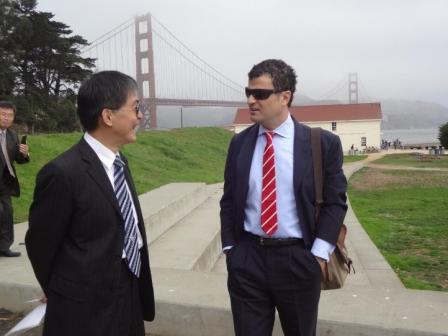 EPAT Minister Wei met EPA Region 9 Administrator Jared Blumenfeld for the launch of CCAP at San Francisco’s Golden Gate National Recreation Area. (August 2014)
EPAT Minister Wei met EPA Region 9 Administrator Jared Blumenfeld for the launch of CCAP at San Francisco’s Golden Gate National Recreation Area. (August 2014)- August 2014: To help address the dual challenge of air pollution and climate change, EPA Region 9 (Pacific Southwest) Administrator Jared Blumenfeld, EPAT Minister Wei Kuo-yen, and Bjarne Pedersen from Clean Air Asia launched the Cities Clean Air Partnership at a ceremony in San Francisco. CCAP will keep cities moving towards clean air targets through its innovative city certification program that will provide incentives, direct support, and technical assistance.
- July 2014: EPA, EPAT, and VEA co-hosted the 4th annual International E-Waste Management Network (IEMN) meeting in Hanoi to provide an open forum for developing the necessary knowledge, skills, and abilities to more effectively manage growing e-waste inventories worldwide. Participants included representatives from: Thailand, Malaysia, Indonesia, Japan, Colombia, Argentina, El Salvador, Brazil, Nigeria, Costa Rica, Egypt, Canada, and Mexico.
- April 2014: Administrator McCarthy traveled to Taiwan to commemorate the 20 year anniversary of EPA-EPAT cooperation and joined Taiwan President Ma Ying-jeou and EPAT Minister Wei Kuo-yen for the launch of the International Environmental Partnership (IEP). [See EPA remarks at the event.]
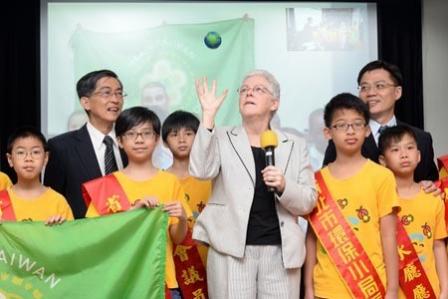 Administrator McCarthy visited Jian-An Elementary School with EPAT Minister Wei during her trip to Taiwan. (April 2014)
Administrator McCarthy visited Jian-An Elementary School with EPAT Minister Wei during her trip to Taiwan. (April 2014)- July 2013: EPA and EPAT organized the third annual meeting of the International E-waste Management Network (formerly the GEM Network) in Sacramento and San Francisco, CA. The meeting introduced participants to the various policies, programs and activities (both governmental and non-governmental) that contribute to e-waste management in the U.S.
- July 2013: Commemorating 20 years of environmental cooperation, Acting EPA Administer Bob Perciasepe met with EPA Taiwan (EPAT) Minister Stephen Shen and congratulated Taiwan on its emergence as an environmental leader. He commended EPAT for leveraging the bilateral partnership into regional cooperation on mercury monitoring, managing electronic waste, site remediation, sustainable ports, environmental information, and enforcement. Minister Shen also held meetings with local and other federal partners.
- July 2013: Minister Shen and EPA Associate Assistant Administrator Joel Beauvais launched the Asia-Pacific Mercury Monitoring Partnership. Meeting participants from Taiwan, United States, Canada, Thailand, Indonesia, Korea, Japan, and Vietnam agreed to launch a collaborative regional mercury monitoring pilot network under a common framework for operations, quality assurance, and data management. Three new mercury monitoring stations in Southeast Asia are planned for early 2014.
- June 2013: EPA staff joined American Institute in Taiwan Director Christopher Marut, and Taiwan's Minister for Environment Dr. Stephen Shu-hung Shen, in Taipei for the unveiling of the Historical Exhibit Commemorating 20 Years of U.S.-Taiwan Environmental Cooperation. Exit [See EPA remarks at the event.] EPA staff also opened technical workshops on site remediation and environmental enforcement.
- June 2013: EPA and EPAT held a four-day environmental enforcement workshop for 30 inspectors from Taiwan. The workshop, which took place in Chungli, demonstrated inspection processes and techniques via a two-day, EPA-led mock inspection of a major refinery. The workshop also explored injunctive relief and penalties with a combination of lectures, case studies, and classroom exercises.
Activities
Promoting Environmental Education
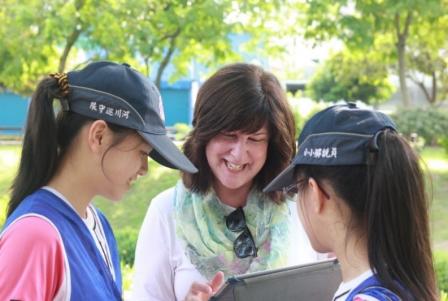 Delegation of US educators visited an elementary school in Tainan as part of the Eco-Campus Partnership Program.
Delegation of US educators visited an elementary school in Tainan as part of the Eco-Campus Partnership Program.EPA collaborates with EPAT to integrate environmental education into all sectors of society including businesses, schools, communities, and families. EPA and EPAT coordinate programs such as Eco-Campus Partnership Programs, Kids Making Sense, and the Global Environmental Education Partnership to promote quality environmental education and empower youth around the world to drive positive change in their communities.
Programs include:
- Eco-Campus Partnership Programs Exit
- Kids Making Sense Exit
- Global Environmental Education Partnership (PDF) (10 pp, 3.2 M, About PDF) Exit
Cleaning Up E-waste
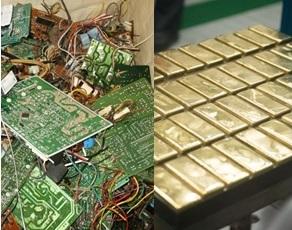 E-waste is processed into gold at a state of the art recycling facility in Taipei.
E-waste is processed into gold at a state of the art recycling facility in Taipei.Discarded cell phones, tablets, and other electronic devices are far from valueless. E-waste, as these discarded items are commonly called, can be recycled to reintroduce gold, silver, copper, and other valuable materials into supply streams for future use. Recycling e-waste can not only provide these valuable elements as a useable resource but it prevents materials from being thrown into landfills.
E-waste can also contain harmful materials, like lead and mercury, which can pollute the environment and endanger human health. Consequently, there will be negative impacts on people and communities if recycling or disposal of e-waste is conducted without proper protection for workers and the environment.
EPA and EPAT have collaborated since 2011 to build global capacity for the environmentally sound management of waste electrical and electronic equipment (WEEE). To support this goal, EPA and EPAT coordinate the International E-Waste Management Network (IEMN). The IEMN enables environmental officials from within and beyond the Asia-Pacific region to exchange information and best practices on e-waste management.
Learn more about the International E-Waste Management Network (IEMN).
Improving Air Quality
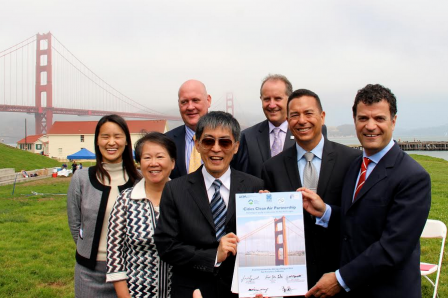 Clean Air Asia, USEPA, EPAT, and the initial partners from the Bay Area and South Coast Air Quality Districts launched CCAP in San Francisco.
Clean Air Asia, USEPA, EPAT, and the initial partners from the Bay Area and South Coast Air Quality Districts launched CCAP in San Francisco.According to the World Health Organization, Exit approximately 7 million people died in 2012 as a result of air pollution exposure. To address this challenge, EPA and EPAT have collaborated on air quality protection for nearly twenty years. Together with regional partners, experts from the two agencies are currently working to reduce air pollutant emissions from ships and ports operations.
EPA and EPAT partner with the Cities Clean Air Partnership to strengthen air quality management in Asian cities, encourage progress, and contribute to reducing the health impacts of air pollution and climate change in Asia. The two agencies also partner with the National Atmospheric Deposition Program (NADP) to improve the capacity for atmospheric mercury monitoring, data for analysis, and modeling, and the accuracy of mercury emissions inventories with other partners in the Asia-Pacific region.
Programs include:
- Cities Clean Air Partnership Exit
- AirNow-International Exit
- Promoting Sustainable Ports in the Asia-Pacific Region
- Asia-Pacific Mercury Monitoring Partnership through the National Atmospheric Deposition Program Exit
Reducing Exposure to Toxic Chemicals
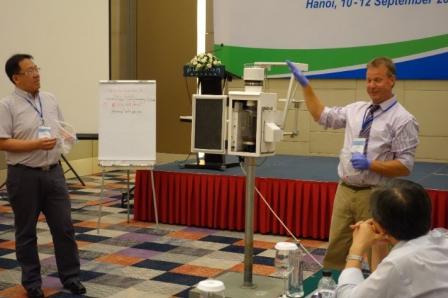 International experts at the 3rd APMMN Workshop exchange scientific information on programs that monitor atmospheric mercury concentrations, wet and dry mercury deposition, and related pollutants.
International experts at the 3rd APMMN Workshop exchange scientific information on programs that monitor atmospheric mercury concentrations, wet and dry mercury deposition, and related pollutants.Mercury is a naturally occurring element widely found throughout the environment. Processes such as power generation from coal-fired power plants, incineration of waste, and metal processing emit mercury to the atmosphere. Like many forms of air pollution, mercury transcends national borders. Increasing industrialization has made Asia the main source region of mercury emissions to the global atmosphere.
To address this, EPA has partnered with EPAT, the National Atmospheric Deposition Program, and Taiwan’s National Central University to launch the Asia Pacific Mercury Monitoring Network (APMMN) in 2012. APMMN aims to share information, data, tools, and technologies to expand coordinated mercury monitoring capacity in the Asia Pacific region, provide training and support to scientists in the region, and develop baseline mercury data useful to regional and global modelers. APMMN seeks to systematically monitor wet deposition and atmospheric concentrations of mercury in a consistent, standardized network of stations throughout the region.
Programs include:
Expanding Access to Clean Water
With rapid economic development, soil and groundwater pollution has become an increasingly serious challenge for many developing countries in Asia. Contaminated sites impact human health, particularly the poor, children, elderly and other vulnerable communities. Cleaning up contaminated sites reduces the impact of pollutants on groundwater sources. This improves ecological systems and the food supply both in Asia and the U.S.
To achieve this, EPA and EPAT experts serve as technical trainers for agencies and institutions across the Asia-Pacific region on the clean-up of contaminated sites, addressing topics such as forced-air remediation, bioremediation and phyto-remediation.
Programs include:
Combating Climate Change by Limiting Pollutants
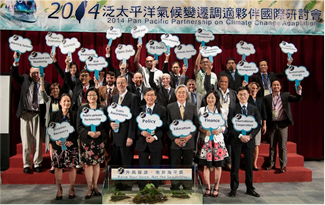 Environmental leaders from around the world proposed 26 solutions to address climate change at the 2014 Pan Pacific Partnership on Climate Change Adaptation
Environmental leaders from around the world proposed 26 solutions to address climate change at the 2014 Pan Pacific Partnership on Climate Change AdaptationClimate change and global warming can increase the frequency of extreme weather events and cause sea levels to rise, which adversely impact on ecosystems, economic development and human health across the world. The Pan Pacific region is particularly vulnerable to the impacts of climate change as it includes several low-lying countries with long coastlines and small island developing countries.
EPA collaborates with EPAT to share expertise in development of emissions inventories and strategies to reduce greenhouse gases. The two agencies are taking the lead in bringing Pan-Pacific partners together, including Southeast Asia and Pacific Island nations, to deliver comprehensive cooperation on climate change adaptation.
Building Strong Institutions and Legal Structures
Strong environmental laws that protect our natural resources and safeguard our health must be complemented by effective enforcement. To establish an enforcement regime that effectively detects, corrects, and deters violations requires thoughtful strategies, well trained inspectors, supporting legal tools, and a fair and just sanction system.
EPA and EPA Taiwan are currently cooperating bilaterally on issues of environmental enforcement. The two organizations are also working together to share new methods and approaches with each other and other partners.
Current partners include:
Key Partners
The following links exit the site Exit
- Environmental Protection Administration Taiwan
- American Institute in Taiwan
- Taipei Economic and Cultural Representative's Office
-
Agreements
- View the agreement. (PDF) (1 pp, 29 K, About PDF)
